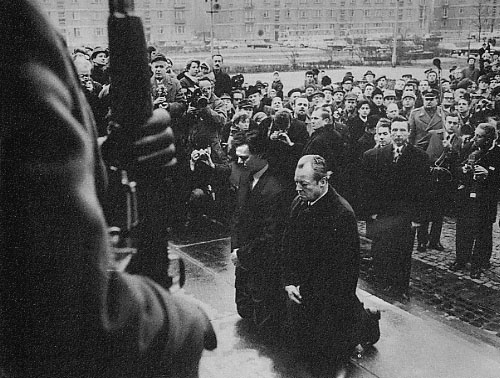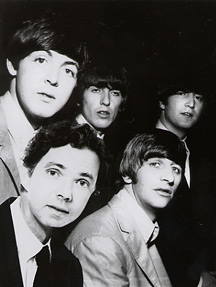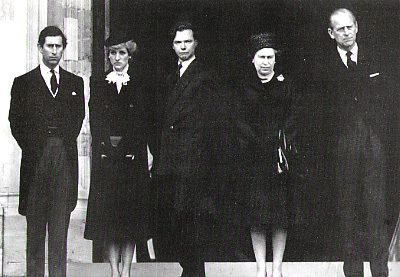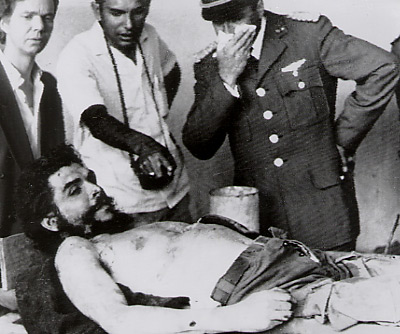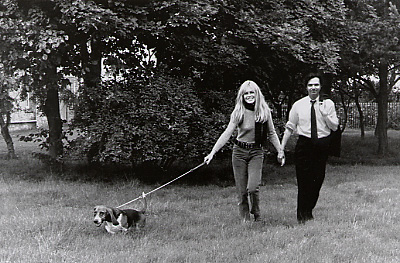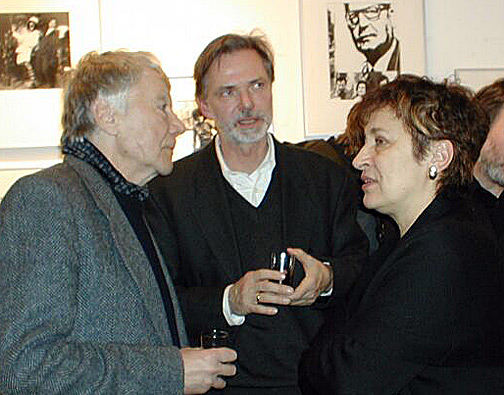Mala Gallery
8, Zamkowy Sq., Warsaw (Old Town)
January 7-31, 2003
Matthias Wähner: "Man without properties"
Matthias Wähner: "Man without properties"
Mala Gallery, Warsaw, January 2003
Matthias Wähner: from series "Man without properties", Mala Gallery, Warsaw, January 2003
S IT could be expected such a deliberately destitute of respect approach to photographs - icons which contain a strong emotional charge and to the scenes from contemporary history of unquestioned importance caused reactions full of unrest and rancour. Obviously these photographs have found themselves between different front lines of political corectness and have made mess on ideological flowerbeds because a man seen on them - unknown and unwanted as well - invaded into intimacy of this sphere in which privacy of identifications - negative and positive as well - is being guarded. It makes great impact since it does not matter if Wähner invites himself to the foreground of secularised altar scene such as this in which Willy Brandt is kneeling down in Warsaw or if the artist is sneaking into ranks of „sad men” from the Federal Criminal Bureau who just arrested Ulrike Meinhof or is standing with compassionate look next to Che Guevara's deathbed, is conversing with Klaus Barbie and Uwe Barschel or is running down a pasture land hand in hand with Brigitte Bardot, is sitting in the drawing-room of Simone de Beauvoir, is settling himself comfortable on a couch next to Bokassa or is bathing with shah of Iran - such manipulation always is a critical comment on grandiloquence and negatively or positively emphasized devotional character of the original photographs, it blows out from the inside currently binding interpretations of motifs, which through years fixed themselves in people's minds, approaching them with irony at the same time. The artist called this series of photographs „Man without properties” and the cover of the catalogue is a quotation from now available edition of the Robert Musil's novel. Behind this title is hidden not only the artist who practises his travesties on the crossroads of the recent political and cultural history. The quotation from the Musil's novel is also a fine quintessence of ever imperfect, melancholic but productive creative spirit of his own generation. In 1960's and 1970's countless numbers of young people with their doubts and considerations had been reading the „Man without properties” despite that many of them already at „holy talks” of Ulrich and Agatha were getting bored and gave up reading of this elaborate book - excellent but nerve killing in its intellectual celebration of details - and dropping it long before the book began to crawl towards to its unfinished end.
„Nothing is true and everything is permitted” - this saying of ancient Assassins comes to one's mind when looking at these pictures. Since 1989 immemorial political values corroded substantially and faith in promissing future - of the art at least - has found itself in horrible depression. Such art has positively its appropriate place in these disquieting times, when we now exactly what was but we do not know at all what will be.
Heinrich v. Berenberg, „Fälscher im Devotionalienkabinett. Über Matthias Wähner und seine Kunst”, Freibeuter nr 69, June 1994, Verlag Klaus Wagenbach
Matthias Wähner: "Man without properties"
Mala Gallery, Warsaw, January 2003
Matthias Wähner: "Man without properties"
Mala Gallery, Warsaw, January 2003
Matthias Wähner: "Man without properties"
Mala Gallery, Warsaw, January 2003
See also:
Opening of the exhibition in Mala Gallery, Warsaw, on January 7th 2003. Matthias Wähner (center) in conversation with Polish artist Tadeusz Rolke (left). Photo A. Mazur
back to FOTOTAPETA's front page
Copyright © 1997-2025 Marek Grygiel / Copyright for www edition © 1997-2025 Zeta-Media Inc.
08 - 01 - 2003
